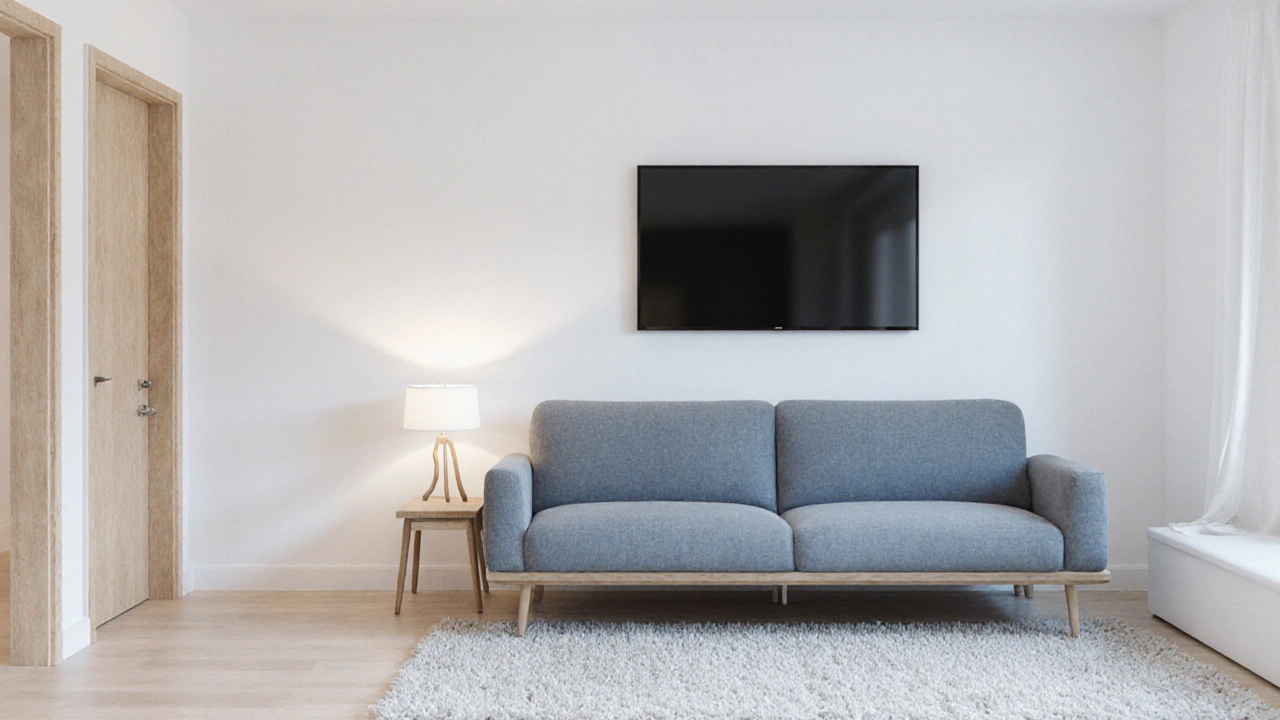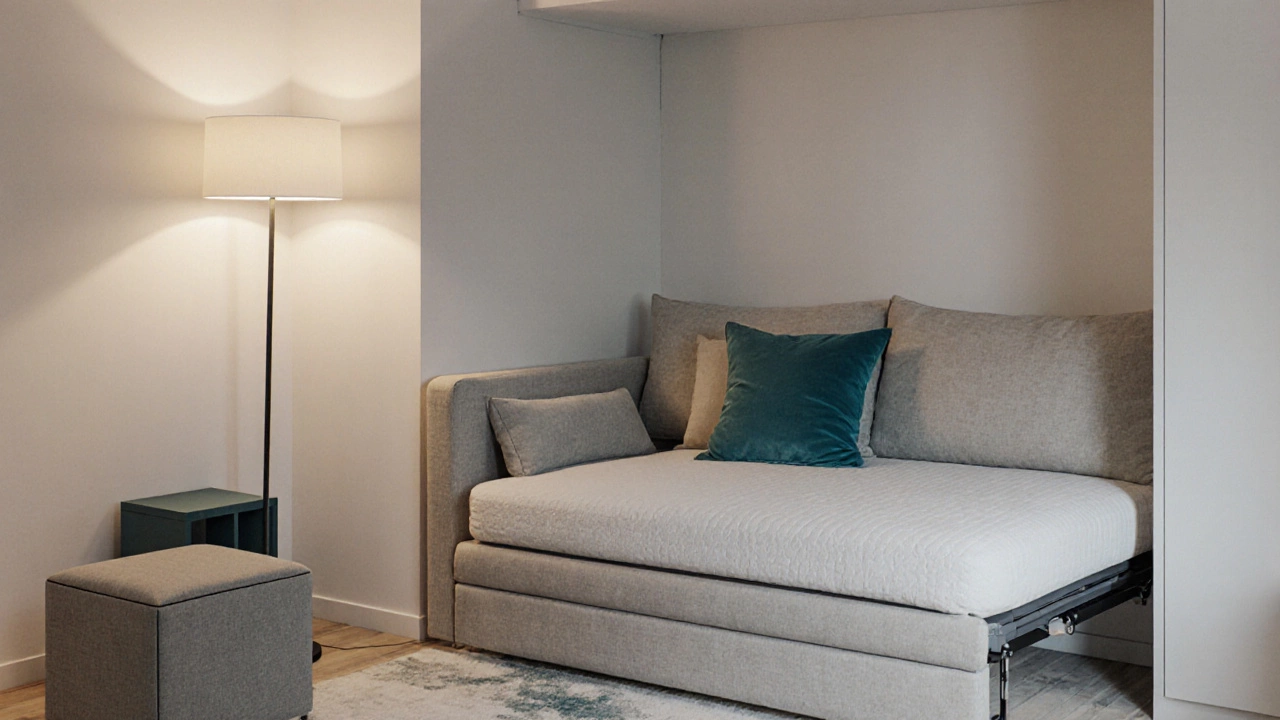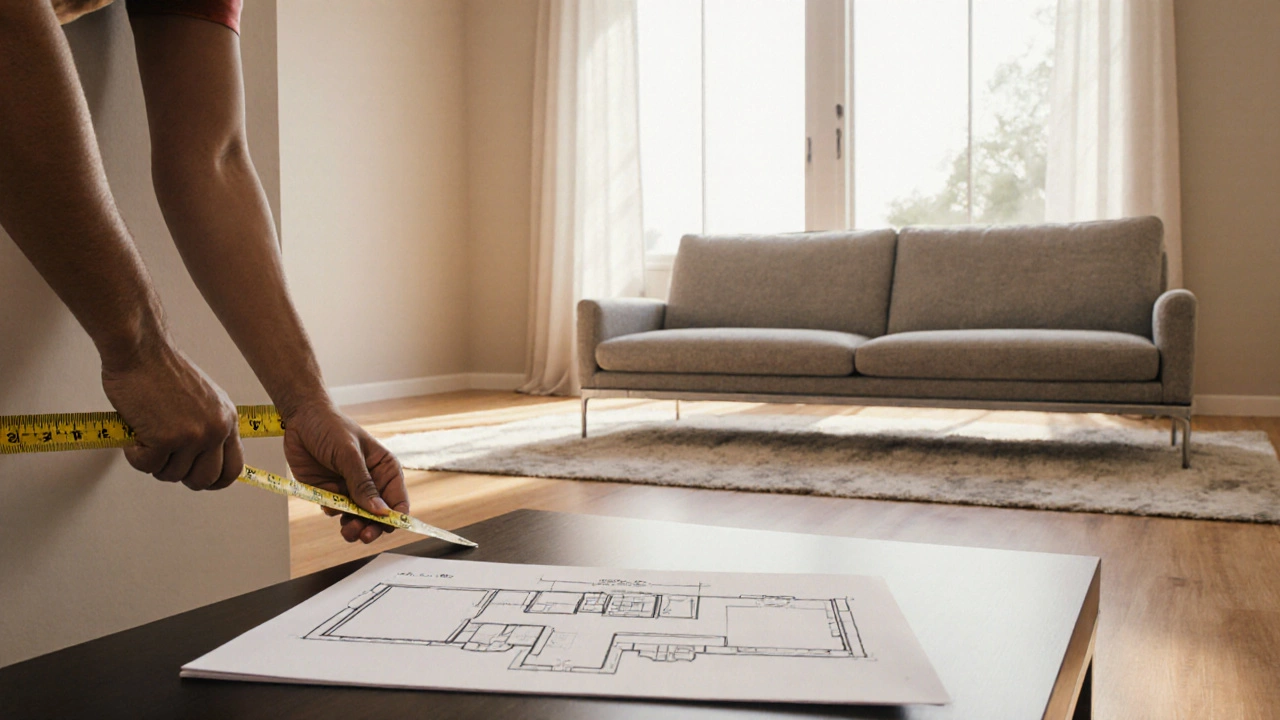Sofa Bed Placement Calculator
Measure Your Room
Enter your room dimensions to see if it has enough space for your sofa bed placement.
Key Takeaways
- Measure your room and the sofa bed’s dimensions before you decide.
- In a living‑room setting, place the sofa bed against a solid wall to keep traffic flow smooth.
- For studio apartments, a corner or a wall‑mounted bracket can double your usable space.
- Bedroom placement works best when the bed doubles as a nightstand or workspace.
- Mind lighting, rugs, and nearby furniture to avoid tripping hazards.
Imagine pulling a comfortable bed out of a sleek couch and instantly freeing up the living area for guests. That magic trick only works if the sofa bed placement is spot‑on. Too often people cram a sofa bed into the first empty wall, only to find it blocks the doorway or makes the room feel cramped. This guide walks you through the science of space, the art of flow, and the practical steps for finding the perfect spot - whether you live in a sprawling house or a tiny studio.
Understanding Your Space
Before you start pushing furniture around, get a clear picture of three things: room dimensions, traffic patterns, and the sofa bed’s footprint.
Sofa Bed is a multi‑functional piece of furniture that serves as both a couch and a bed, usually featuring a fold‑out mattress. Typical sofa beds range from 73 inches wide (full‑size) to 85 inches (queen‑size) and can be as deep as 40 inches when open.
Use a tape measure to note the length of each wall, the height of the ceiling, and the width of any doorways or windows. Sketch a simple floor plan on paper or a free app; draw the sofa bed in both its closed and open positions. This visual trick instantly shows you if the bed will swing into a hallway or block a window.
Next, trace the primary traffic flow - the path people naturally take from the entryway to the focal point (often a TV or fireplace). Any placement that interrupts this flow will feel cluttered, no matter how stylish the sofa bed looks.
Common Placement Options and Their Pros & Cons
| Location | Pros | Cons | Ideal Room Size |
|---|---|---|---|
| Against a Solid Wall (Living Room) | Stable back support; easy to pull out; keeps traffic clear | May limit wall‑mounted décor | 12 ft × 14 ft or larger |
| Corner Placement (Studio) | Maximises floor space; creates a cozy nook | Can be tricky to open; may reduce sitting area | 10 ft × 10 ft or larger |
| Floating Center (Open‑Plan) | Creates a focal point; works in modern layouts | Requires a large, unobstructed area; may disrupt flow | 15 ft × 20 ft or larger |
| Behind a Wall‑Mounted Bracket (Studio) | Leaves floor clear; best for micro‑apartments | Installation needed; weight limits apply | 8 ft × 10 ft minimum |
| In a Guest Bedroom | Dual‑purpose; easy to hide | May feel less like a true bedroom; limited seating | 9 ft × 11 ft or larger |

How to Choose the Right Spot for Your Sofa Bed
Follow this step‑by‑step decision tree:
- Is the room primarily a living area?
Yes → Look for a solid wall with enough clearance (at least 2 ft) for the extended mattress. - Do you have a studio or one‑room layout?
Yes → Consider a corner or a wall‑mounted bracket to keep the floor open. - Is the sofa bed the main sleeping solution?
Yes → A bedroom or dedicated guest room works best, allowing you to add night‑stand accessories. - Do you need extra storage?
Yes → Choose a model with built‑in drawers or pair it with modular furniture that can hide bedding.
Answering these questions narrows the options down to the placement that matches both function and style.
Practical Tips for Each Placement
Living Room the central gathering area in a home, typically featuring seating, entertainment equipment, and décor placement works best when the sofa bed faces the main focal point. Keep a side table within arm’s reach so you can set a lamp or a book before you unfold the bed. Use a low‑profile Area Rug a textile floor covering that defines a space and adds comfort under the sofa to anchor it without adding height that could interfere with the mattress’s drop.
For Bedroom a private sleeping space, often with a bed, wardrobe, and nightstands placement, align the sofa bed with the existing bed’s side wall. This lets you pull the sofa out without bumping into the wardrobe doors. Consider a headboard that doubles as a shelf for books or a small table lamp.
In a Studio Apartment a compact living space where living, sleeping, and cooking areas share the same floor plan, a corner placement saves floor area. Pair the sofa bed with a Foldaway Mattress a thin, lightweight mattress that folds into a compact shape for easy storage that’s no thicker than 4 inches when folded. If the ceiling height permits, a wall‑mounted bracket (think “Murphy‑style”) can hide the mattress vertically, freeing up the whole room when the bed is stored.
When you use a Wall‑Mounted Bracket a hardware system that secures a sofa bed to the wall when not in use, be sure the studs can support the weight (usually 200-300 lb). Follow the manufacturer’s installation guide and use a level to avoid a lopsided pull‑out.
Combine the sofa bed with Modular Furniture adaptable pieces that can be rearranged to suit different needs like a rolling storage ottoman that doubles as a nightstand. This keeps essentials-pillows, bedding, remote controls-within reach without cluttering the floor.

Avoiding Common Mistakes
- Blocking Doorways: Always leave at least 30 inches of clear space in front of doors.
- Ignoring Mattress Thickness: A thicker mattress may require more clearance from the ceiling or adjacent furniture.
- Neglecting Lighting: Placement under a dim corner can make it hard to set up the bed. Add a floor lamp or wall sconce.
- Forgetting Traffic Flow: If the sofa bed sits in the middle of the room, you’ll end up with a “traffic jam” every night.
- Overlooking Flooring: Hardwood floors can be scratched by the mattress’s frame. Use felt pads or a rug to protect the surface.
FAQ
Can I place a sofa bed in a hallway?
It’s generally a bad idea. Hallways need clear width for moving in and out of rooms. A sofa bed that opens into a hallway can block access and create a safety hazard.
What is the minimum clearance needed for a queen‑size sofa bed?
A queen‑size sofa bed typically measures 85 inches wide and 40 inches deep when opened. You’ll need at least 5 feet of clear space in front of the bed and 3 feet on each side to ensure smooth unfolding.
Is a wall‑mounted bracket safe for a heavy sofa bed?
Yes, if installed into wall studs that can carry the load and if the bracket is rated for the sofa’s weight. Always follow the manufacturer’s weight limit and use a level during installation.
Should I use a rug under a sofa bed?
A low‑pile rug protects the floor and adds comfort, but keep it thin enough not to interfere with the mattress’s mechanism. A rug under the legs only is a safe compromise.
How do I keep the sofa bed from feeling cramped in a small room?
Choose a model with a slim frame and a thin mattress, place it against a wall or in a corner, and use multi‑functional storage pieces nearby. Light colours on walls and furniture also create a sense of space.
Next Steps
Grab a tape measure, sketch your floor plan, and test the sofa bed’s footprint with cardboard cut‑outs. If you’re still unsure, try the quick test: tape a rectangle the size of the opened bed onto the floor and walk around it. Does it feel natural? If not, rethink the placement before you buy.
Remember, the best spot isn’t just about aesthetics - it’s about creating a flow that lets you relax, sleep, and entertain without tripping over a mattress. Happy arranging!

